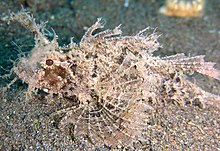| Pteroidichthys | |
|---|---|

| |
| Pteroidichthys amboinensis | |
| Scientific classification | |
| Domain: | Eukaryota |
| Kingdom: | Animalia |
| Phylum: | Chordata |
| Class: | Actinopterygii |
| Order: | Perciformes |
| Family: | Scorpaenidae |
| Tribe: | Scorpaenini |
| Genus: | Pteroidichthys Bleeker, 1856 |
| Type species | |
| Pteroidichthys amboinensis Bleeker, 1856 | |
| Synonyms | |
| |
Pteroidichthys is a genus of marine ray-finned fish belonging to the family Scorpaenidae, the scorpionfishes. The scorpionfishes in this genus are distributed in the Indian and Pacific Oceans.
Taxonomy
Pteroidichthys was first described as a genus in 1856 by the Dutch herpetologist, ichthyologist and physician Pieter Bleeker when he described Pteroidichthys amboinensis and he placed it in a monotypic genus. The genus name is a compound of pteroides which means "similar to Pterois", and ichthys meaning "fish". Bleeker thought that this taxon was close to the lionfishes but was distinguished by, among other features, the lack of head spines.
Species
There are currently 4 recognized species in this genus:
- Pteroidichthys acutus Motomura & Kanade, 2015 (Longsnout weedy scorpionfish)
- Pteroidichthys amboinensis Bleeker, 1856 (Ambon scorpionfish)
- Pteroidichthys caussei Motomura & Kanade, 2015 (Causse's scorpionfish)
- Pteroidichthys noronhai (Fowler, 1938) (Noronha's scorpionfish)
Characteristics
Pteroidichthys scorpionfishes have a body which is strongly compressed and elongated, the width of the body is equivalent to 10–24% of their standard length while its depth is equivalent to 28–40% of its standard length. They have 12 spines in their dorsal fin and there are no black blotches on the lower part of the caudal fin. These scorpionfishes vary in size from a maximum standard length of 4.1 cm (1.6 in) in P. acutus to a total length of 12 cm (4.7 in) in P. amboinensis.
Distribution and habitat
Pteroidichthys scorpionfishes are found in the Indian Ocean and the western Pacific Ocean, occurring in the Red Sea as well. It is found as far north as Japan and south to Australia. They are demersal fishes which occur over soft substrates. These fishes are found in depths that range from 7 to 400 m (23 to 1,312 ft).
Biology
Pteroidichthys scorpionfishes are ambush predators and tend to be solitary fishes.
References
- ^ Eschmeyer, William N.; Fricke, Ron & van der Laan, Richard (eds.). "Genera in the family Scorpaenidae". Catalog of Fishes. California Academy of Sciences. Retrieved 25 January 2022.
- Christopher Scharpf & Kenneth J. Lazara, eds. (2 October 2021). "Order Perciformes (Part 9): Suborder Scorpaenoidei: Family Scorpaenidae". The ETYFish Project Fish Name Etymology Database. Christopher Scharpf and Kenneth J. Lazara. Retrieved 26 January 2022.
- ^ Froese, Rainer; Pauly, Daniel (eds.). "Species in genus Pteroidichthys". FishBase. August 2021 version.
- ^ Motomura, H. & Kanade, Y. (2015). "Review of the scorpionfish genus Pteroidichthys (Scorpaenidae), with descriptions of two new species". Zootaxa. 4057 (4): 490–510. doi:10.11646/zootaxa.4057.4.2.
- Dianne J. Bray. "Pteroidichthys". Fishes of Australia. Museums Victoria. Retrieved 27 January 2022.
- Fricke, Ronald; Golani, Daniel & Appelbaum-Golani, Brenda (2015). "Confirmed record of the Ambon scorpionfish, Pteroidichthys amboinensis from the Red Sea (Teleostei: Scorpaenidae)". Marine Biodiversity Records. 8 (e113). doi:10.1017/S1755267215000949.
- ^ Motomura, H. & Matsuura, K. (2016). "Pteroidichthys noronhai". IUCN Red List of Threatened Species. 2016: e.T69799144A69801017. doi:10.2305/IUCN.UK.2016-3.RLTS.T69799144A69801017.en. Retrieved 26 January 2022.
- ^ Motomura, H. & Matsuura, K. (2016). "Pteroidichthys amboinensis". IUCN Red List of Threatened Species. 2016: e.T69798967A69801012. doi:10.2305/IUCN.UK.2016-3.RLTS.T69798967A69801012.en. Retrieved 18 November 2021.
| Taxon identifiers | |
|---|---|
| Pteroidichthys | |